The setting of a story is a powerful tool that captivates readers and enhances the narrative. It goes beyond being a mere backdrop; the story setting helps to shape characters, their motivations, and the plot itself. Crafting a well-written setting can be challenging, with the risk of overwhelming readers with too many details or leaving them with an insufficient sense of place. In this article, we will explore effective strategies for writing an engaging story setting that leaves a lasting impact on readers.
What is the setting of a story?
The setting of a story is the context in which the narrative unfolds. It encompasses the time, place, and environment in which the events take place. The story setting plays a crucial role in establishing the mood, developing the plot, and bringing the characters to life. It is more than just a backdrop; it is an integral part of the storytelling experience.
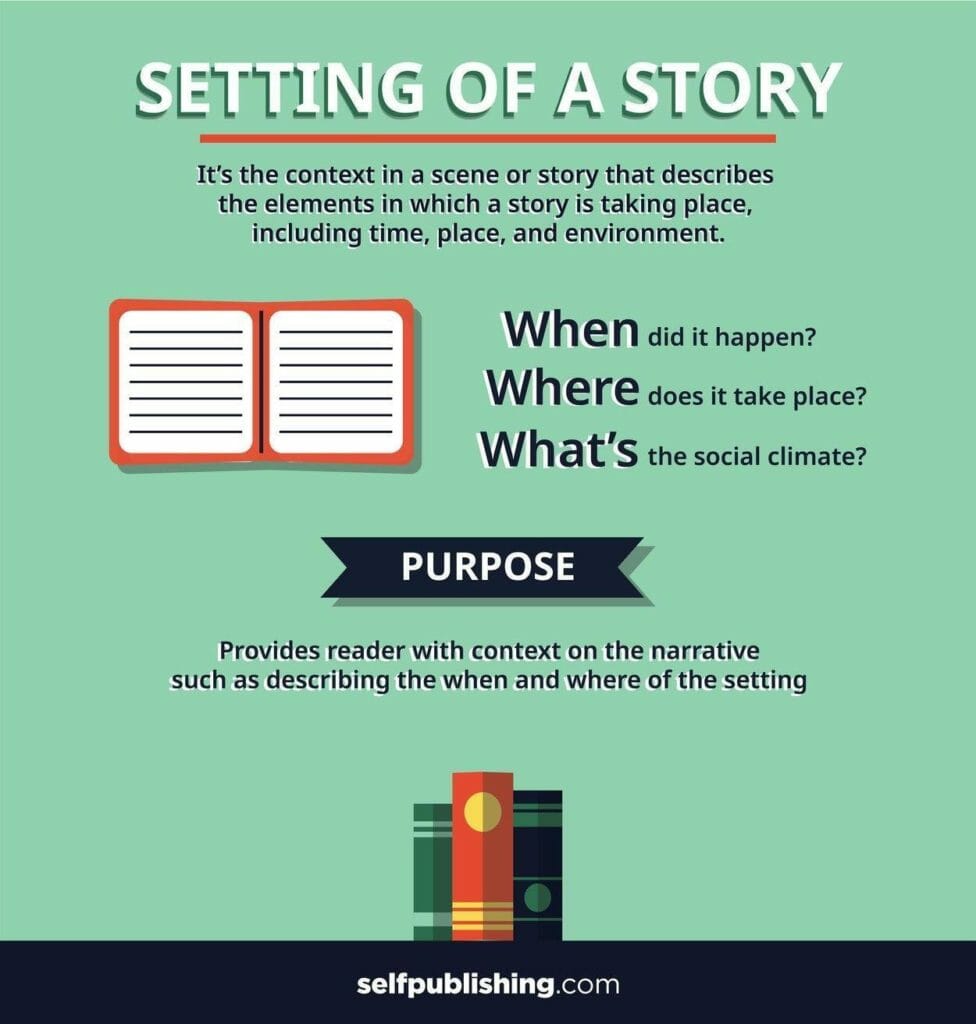
What is the purpose of the setting of a story?
The setting of a story serves several important purposes. First and foremost, it provides readers with key contextual information about the narrative. It answers questions about where and when the story takes place, the social climate, important events, and societal norms. By immersing readers in the story’s setting, writers can evoke an emotional response and engage them more deeply in the narrative.
Examples of compelling story settings
Well-crafted story settings can transport readers to different places and times, allowing them to experience the story in a more vivid and immersive way. For example, in Nora Roberts’ “The Dark Witch,” the setting of Ireland is skillfully described: “The cold carved bone deep, fueled by the lash of the wind, iced by the drowning rain gushing from a bloated sky. Such was Iona’s welcome to Ireland. She loved it. How could she not? She was standing in a castle, in the heart of the west.”
These examples demonstrate how specific and evocative language can help readers visualize the place, social environment, and time period of the story. Effective story settings can be found in both fiction and non-fiction books, creating a powerful connection between the reader and the narrative.
Why is the setting of a story important?
The setting of a story is crucial because it provides readers with important context, enriching their understanding and enjoyment of the narrative. Here are a few key reasons why the story setting is vital:
- Connects the story’s elements: An effective story setting links the characters to the plot, tying together the book’s themes and events.
- Builds meaning to the narrative: Without a well-developed setting, the story may lack depth and meaning, as the setting provides essential context.
- Elicits an emotional response: Engaging story settings actively involve readers, making them invested in the narrative and curious about how it will unfold.
- Helps readers visualize the story: Authors use the story setting to describe the environment, time, and place, providing readers with context and engaging their imagination.
- Improves the story’s flow: A well-crafted story setting ensures that the plot unfolds seamlessly and the events feel authentic.
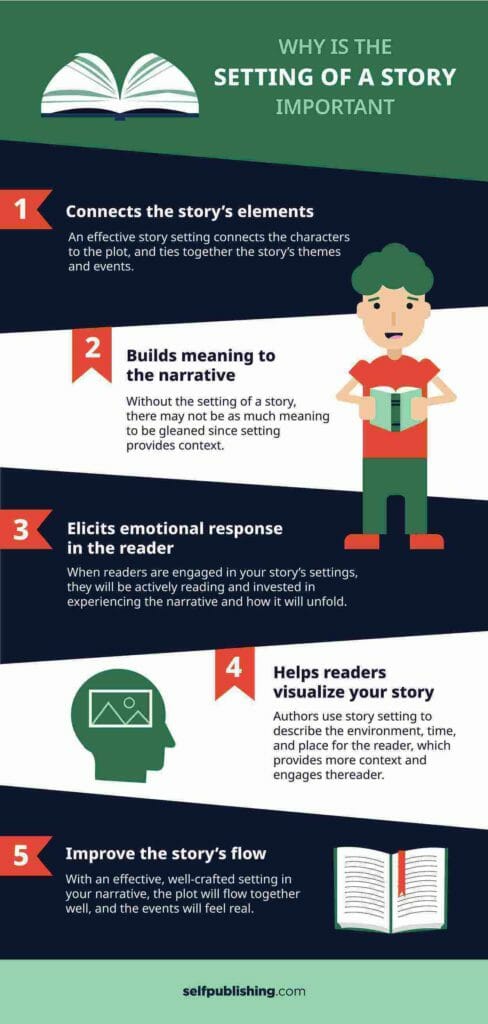
Deciding the setting of a story
When deciding on a story setting, there are three important points to consider:
- Make the setting fit the purpose of your plot: Ensure that the story setting aligns with the overall plot of your story. For example, a murder mystery might be set in a city with high crime rates and a resourceful police station.
- Make the setting fit the story: The setting should be consistent with the story’s events, objects, and overall context. Avoid elements that feel out of place or contradict the reader’s knowledge of a particular time period or place.
- Make the setting fit your characters: The story setting should reflect and align with the characteristics of your main characters. Consider their personalities, backgrounds, and motivations while creating the setting.
Researching the setting of a story
Thorough research is essential when crafting a story setting that is authentic and compelling. Beyond geographic details, the setting encompasses social environments, historical backgrounds, and cultural aspects. To research the setting of a story effectively, consider the following guiding questions:
- What nationalities are represented in the population?
- How dense is the population?
- What is the primary religion of the area?
- What other religions are present?
- What old wives’ tales and superstitions shape the plot and reactions of the characters?
- What are the terrain and geographical features?
- What are the typical weather patterns and climate?
- What is the government like?
- What is the area’s history?
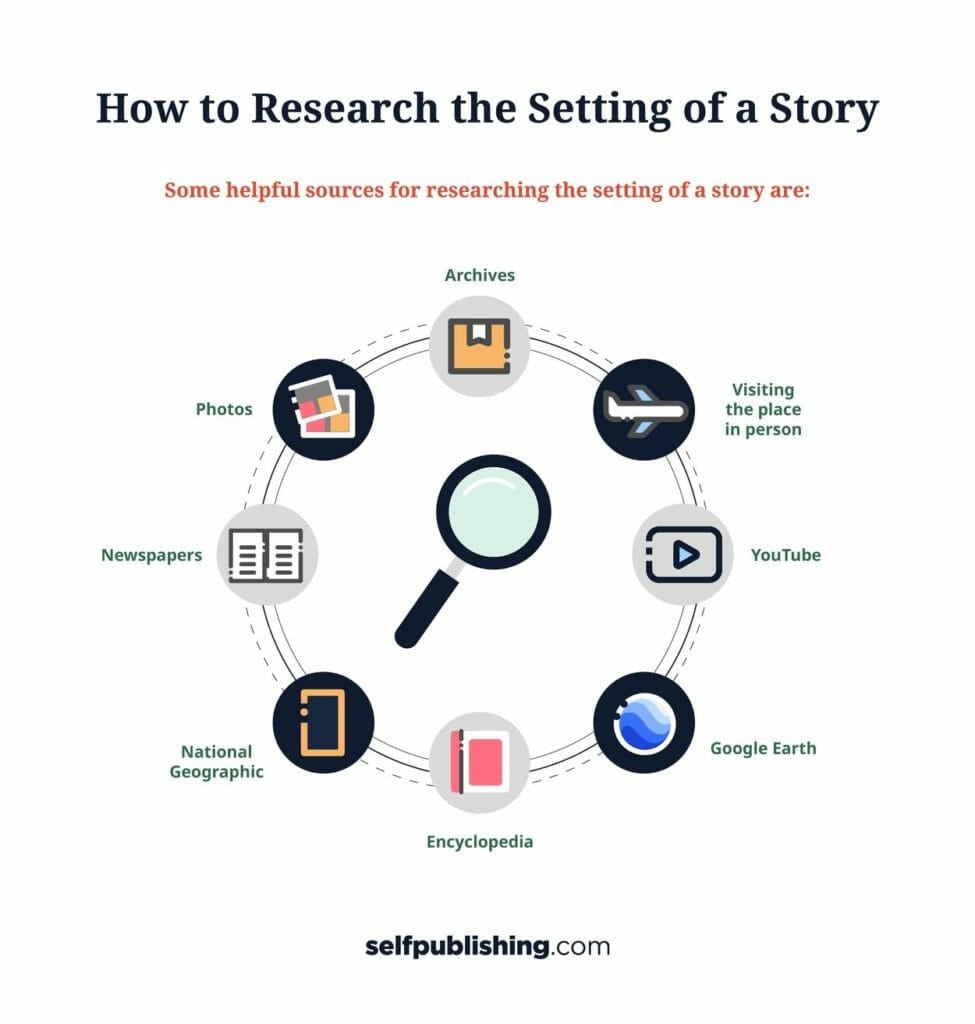
To aid your research, utilize various sources such as visiting the place in person, watching related videos on YouTube, using tools like Google Earth, consulting encyclopedias, accessing high-quality images from National Geographic, exploring newspapers, and searching for relevant photos on the internet. Incorporating these details into your story setting will enhance its authenticity and captivate readers.
How to write the setting of a story
Crafting an engaging setting requires thoughtfulness and attention to detail. Here are some crucial tips to help you create a compelling story setting:
1. Decide what mood you want to establish
The mood of your story setting influences how readers feel while reading the narrative. Consider the emotions you want to evoke and reflect them in your writing. A bright summer morning in a large park creates a different mood compared to a dark forest with low-hanging fog and gnarled trees. Choose words and descriptions that elicit the desired emotional response from your readers.
2. Decide which period or moment best suits your story’s context
The time period plays a significant role in shaping the story’s setting. Consider the plot and select the time period that aligns with its essence. Reflect on the language, idioms, and expressions relevant to that time period. Additionally, explore how people are treated, their beliefs, and their social expectations. These details help establish the context of your story and make it believable.
3. Know the atmosphere you need to portray
The atmosphere in your story setting should match the tone and tension of the scene. Describe the environment and elements that contribute to the desired atmosphere. For example, when portraying high tension, focus on vividly describing elements that imply intensity rather than pleasant sights or sounds. Aligning the story’s atmosphere with the intended narrative ambiance enhances its impact on readers.
4. Incorporate all elements of a story
Go beyond describing the physical aspects of the setting. Consider the government, religions, superstitions, population, and other social dynamics that shape the environment. However, be selective in choosing which elements to include. Only incorporate the details necessary for adequately describing the setting while contributing to the plot and character development. Integrate these details throughout the story to deepen its impact.
5. Use all five senses
Engage readers by incorporating all five senses when describing the story setting. Help readers visualize the environment by describing what they see and guiding their eyes in a natural way. Describe relevant sounds that contribute to the atmosphere. Mention scents and evoke a sense of smell, such as dusty air or the aroma of cooking. Describe textures and objects that characters touch, enhancing reader immersion. Finally, use taste to evoke emotional or sensory experiences. Sprinkle these sensory details throughout your narrative, avoiding overloading readers with excessive descriptions.
6. Don’t describe the setting all at once
Avoid overwhelming readers with an abundance of setting descriptions at the beginning of your story. Instead, incorporate setting details gradually as part of the action. Integrate descriptions into dialogue and sprinkle them throughout the book to deepen the plot and enrich character development. Balancing the pace of your setting descriptions ensures readers remain engaged and immersed in the narrative.
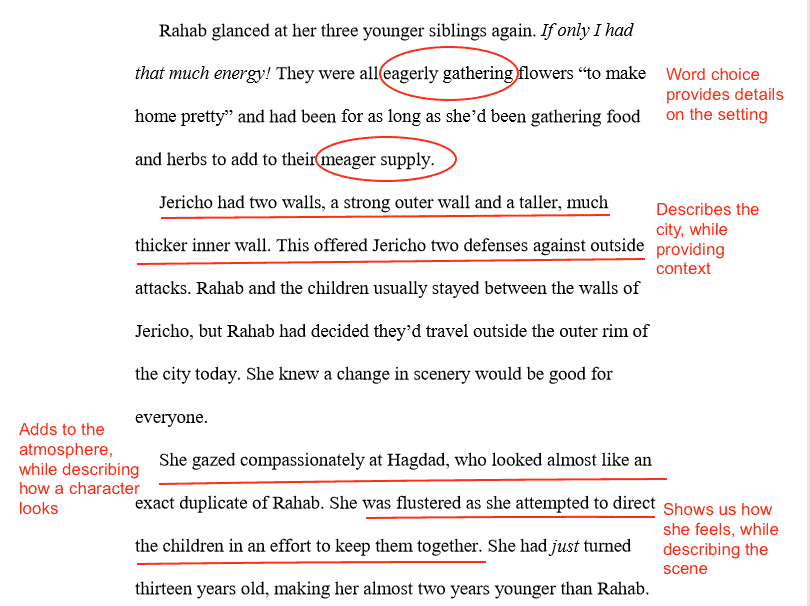
7. Don’t over-describe the setting
Allow room for readers’ imagination by providing enough details to stimulate their senses without stifling their interpretation. Avoid excessive descriptions that can detach readers from the story or overwhelm them. Remember, readers often fill in the gaps with their own imagination, creating a more engaging and personal reading experience.
8. Remember the impact of the setting on characters and the plot
The story’s setting significantly influences the characters and the plot. Consider how the environment affects the characters’ mood, behavior, and motivations. A dreary winter in mid-Michigan might lead to depression, while a desolate trailer park in harsh conditions can evoke sympathy. Aligning the setting with the characters and plot creates a cohesive and immersive reading experience.
Crafting a fictional setting
Creating a fictional setting allows writers to explore imaginative worlds and engage readers in unique and exciting narratives. To develop a fictional setting effectively, follow these key steps:
1. Develop the setting fully before writing
Before starting your narrative, fully develop your fictional setting. Thoroughly research and answer all relevant questions about the world, including its geography, climate, society, and cultures. Establishing a comprehensive understanding of your fictional setting ensures consistency and saves time during the writing process.
2. Create the world first
Creating a fictitious world is a thrilling task for writers. However, it requires careful consideration and attention to detail. Readers may not have prior knowledge or references for elements in your fictional setting, so ensure that you describe them sufficiently. Use evocative language to introduce readers to unfamiliar creatures, objects, or landscapes.
3. Create the setting within your world
Once you have established a fictitious world, craft the specific setting for your story within that world. Consider the number of suns and moons in the sky, the plant and animal life, and the unique features of the environment. Be detailed enough to make the setting believable, providing readers with the necessary information to visualize and immerse themselves in the world you have created.
4. Include enough details to make the world believable
When writing a fictional setting, readers rely on your descriptions to understand the environment fully. Unlike real settings, fictional worlds lack a frame of reference for readers. Therefore, provide details about the sky, flora, fauna, and other key aspects. Guide readers’ imagination without overwhelming them with excessive information.
5. Draw a map
Creating a map of your fictional world helps you visualize and maintain consistency in your setting. Include important locations, terrains, and distances between places to ensure coherence in your narrative. A map also helps readers better understand and connect with the world you have created.
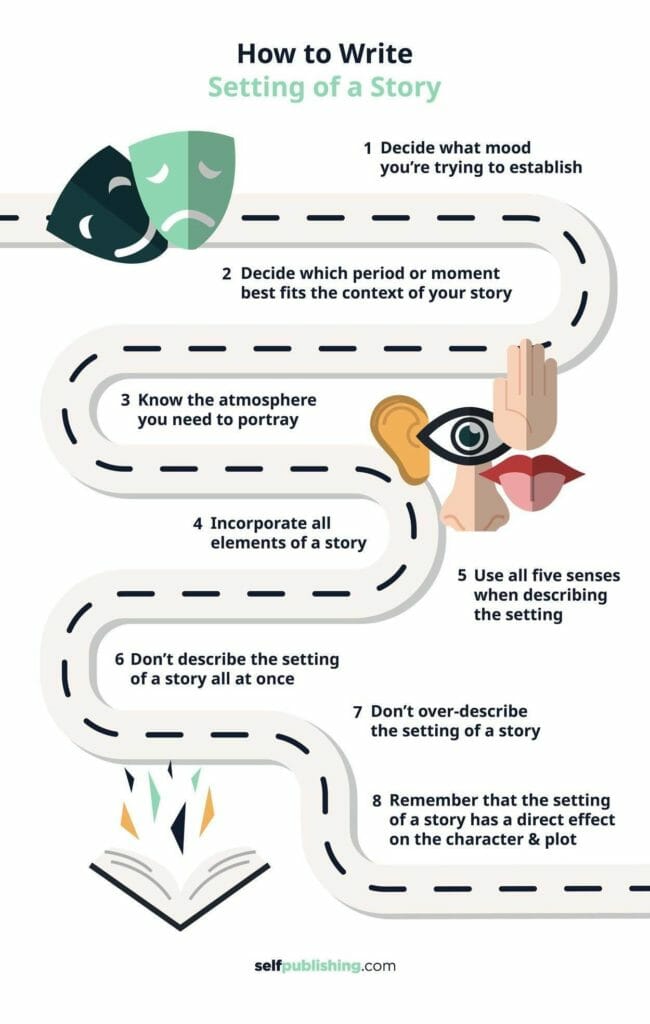
FAQ: Setting of a Story
If you still have questions about crafting an impactful story setting, here are answers to some frequently asked questions:
What are the 3 types of setting?
The three types of setting are time, place, and environment. Each type contributes to the overall story setting and helps create a comprehensive narrative backdrop.
How do you find the setting of a story?
To identify the setting of a story, read through the book or story and note sections where the time, place, and environment are described. Authors often incorporate setting details throughout the narrative, using vivid descriptions and even dialogue to convey the setting’s essence.
How does setting affect the story?
The setting of a story affects the narrative in various ways. It contributes to the plot, character development, and mood, and helps readers visualize the events and context of the narrative. A well-crafted setting enhances the overall reading experience and immerses readers more deeply in the story.
What makes a good setting?
A good setting is one that is aligned with the story’s purpose and overall context. It connects the plot and the characters, builds meaning, elicits emotional responses, helps readers visualize the story, and improves the story’s flow. A good setting engages readers and adds depth to the narrative.
Practice writing the setting of a story
Now that you have learned valuable tips and strategies for creating an engaging story setting, it’s time to start practicing. Take a few moments to think about a story idea and envision its setting. Use your imagination and the techniques discussed in this article to bring the setting to life. Write freely, allow your creativity to flow, and have fun exploring the power of storytelling through vibrant and captivating settings.
Do you have an exciting idea for a story setting? Start writing today and let your imagination take flight! Remember, an immersive setting is the key to captivating readers and creating an unforgettable narrative experience.